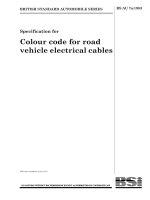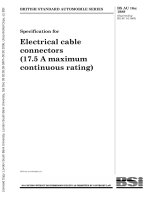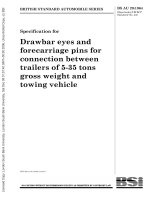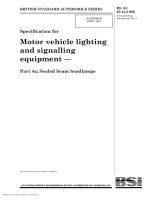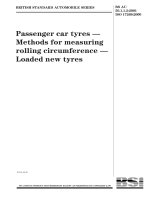Bsi bs au 154a 1989 (2000)
Bạn đang xem bản rút gọn của tài liệu. Xem và tải ngay bản đầy đủ của tài liệu tại đây (285.77 KB, 12 trang )
BRITISH STANDARD AUTOMOBILE SERIES
BS AU
154a:1989
(Superseding
BS AU 154:1 970)
Specification for
Hydraulic trolley jacks
UD C 62 9 . 1 1 9 : 62 1 . 866 – 82 . 0 0 1 . 4. 0 04. 1 5 : 62 0 . 1
BS AU 154a:1989
Committees responsible for this
British Standard
The preparation of this British Standard was entrusted by the Mechanical
Handling Standards Committee (MHE/- ) to Technical Committee MHE/1 2,
upon which the following bodies were represented:
Associated Offices Technical Committee
Association of Loading and Elevating Equipment Manufacturers
British Ports Federation and the National Association of Ports Employers
British Railways Board
British Telecommunications plc
Construction Plant- Hire Association
Department of Health and Social Security
Department of Trade and Industry (Mechanical Engineering and
Manufacturing Technology Division) (MMT)
Electricity Supply Industry in England and Wales
Federation of Wire Rope Manufacturers of Great Britain
Garage Equipment Association
Health and Safety Executive
International Powered Access Federation
London Regional Transport
This British Standard, having
been prepared under the
direction of the Mechanical
Handling and Automobile
Standards Committee, was
published under the authority
of the Board of BSI and comes
into effect on
31 January 1 989
© BSI 02- 2000
First published May 1 970
First revision January 1 989
The following BSI references
relate to the work on this
standard:
Committee reference MHE/1 2
Draft for comment 87/761 36 DC
ISBN 0 580 17093 4
Amendments issued since publication
Amd. No.
Date of issue
Comments
BS AU 154a:1989
Contents
Page
Committees responsible
Foreword
Inside front cover
ii
1
Scope
1
2
Definitions and nomenclature
1
3
General
1
4
Performance
3
5
Corrosion prevention and packaging
3
6
Marking
3
7
Documentation
3
Appendix A Overload type test
4
Appendix B Stability type test
4
Appendix C Proof test
4
Appendix D Typical dimensions of types of hydraulic
trolley j ack (for information)
4
Figure 1 — Hydraulic trolley j ack
2
Figure 2 — Hydraulic trolley j ack positioned on inclined
plane for stability type test
4
Table 1 — Typical dimensions of general purpose and
long reach j acks
5
Table 2 — Typical dimensions of light duty j acks
5
Table 3 — Typical dimensions of kerb j acks
5
Table 4 — Typical dimensions of high lift j acks
5
Publications referred to
© BSI 02- 2000
Inside back cover
i
BS AU 1 5 4 a: 1 989
Fore word
This British Standard has been prepared under the direction of the Mechanical
Handling and Automobile Standards Committee and it supersedes
BS AU 1 54: 1 970, which is withdrawn.
BS AU 1 54: 1 970, which was the first edition, sought to specify the requirements
necessary to ensure that hydraulic trolley j acks are efficient and safe in use,
without thereby inhibiting individual design. This was achieved by not specifying
definite values but instead by allowing a range of values or, in most cases, by
quoting a maximum or minimum value only.
The main features of the previous edition have been retained in this revision.
However, in addition certain design requirements have been specified and light
duty j acks, intended for domestic use, have been included. The test requirements
have also been changed.
Appendix A and Appendix B describe type tests for strength and stability,
Appendix C describes a proof test to be applied to each j ack and Appendix D gives
tables of some typical dimensions of j acks.
A British Standard does not purport to include all the necessary provisions of a
contract. Users of British Standards are responsible for their correct application.
C omp liance with a British S tand ard d oe s no t of itse lf confe r immunity
from le gal ob ligatio ns.
S ummary of p age s
This document comprises a front cover, an inside front cover, pages i and ii,
pages 1 to 6, an inside back cover and a back cover.
This standard has been updated (see copyright date) and may have had
amendments incorporated. This will be indicated in the amendment table on the
inside front cover.
ii
© BSI 02- 2000
BS AU 1 5 4 a: 1 989
1 S cop e
This British Standard specifies requirements for
2.7
cre e p
five types of hydraulic trolley j ack that have been
the tendency of the raised height of the j ack to be
designed for tilting and, in some instances,
reduced over a period of time when the lifting head
manoeuvring vehicles.
is subj ect to a load
The types and ranges of safe working loads (SWL)
are as follows:
3 General
a) general purpose: up to and
3 . 1 O p e ration
including 20. 4 tonnes (see Table 1 ) ;
The j ack shall be designed to be used on a firm, level
b) long reach: up to and including 20. 4 tonnes
surface to lift one end, or one side, or one wheel of a
(see Table 1 );
vehicle, so that a stand or stands can be placed
c) light duty: up to and including 2. 0 tonnes
(see Table 2);
d) kerb: up to and including 6. 5 tonnes
(see Table 3);
e) high lift: up to and including 1 1 . 0 tonnes
(see Table 4).
NOTE
The titles of publications referred to in this standard are
listed on the inside back cover.
under that part of the vehicle.
NOTE
3 . 2 S tre ngth and stab ility
3.2.1
For the purposes of this British Standard, the
following definitions apply and the nomenclature
shown in Figure 1 has been adopted.
The j ack shall be designed with a minimum
factor of safety of
2.5
based on the ultimate tensile
strength of the component parts when supporting
the SWL.
3.2.2
2 D e finitions and nome nclature
An operator should not work under a vehicle that is
supported only by the j ack.
Each type of trolley j ack shall be tested in
accordance with Appendix A and shall show no
permanent deformation or failure of any part and
shall remain fully stable.
3.2.3
Each type of trolley j ack shall be tested in
accordance with Appendix B and shall not overturn
2.1
ge ne ral p urp ose j acks
j acks intended for commercial operation, including
manoeuvring vehicles
2.2
long re ach j acks
j acks similar to general purpose j acks with a
minimum length of 1 800 mm
during the test and shall show no permanent
deformation or failure of any part.
3.2.4
Each trolley j ack shall be tested in accordance
with Appendix C and shall show no visible creep, no
permanent deformation and no failure of any part.
3 . 3 C omp one nt p arts
Each j ack shall comprise a hydraulic pump unit,
reservoir and operating mechanism controlling a
2.3
lifting beam and lifting head housed in a chassis
light d uty j acks
having four or more wheels.
j acks intended for domestic (i. e. non- commercial)
3 . 4 Whe e ls
use. They are not intended for manoeuvring vehicles
The wheels at the handle end shall be of the castor
2.4
type, except in the case of light duty j acks where
ke rb j acks
either castors or rigid wheels are acceptable. These
j acks suitable for easy transportation by virtue of
their short length and detachable handle, intended
for commercial operation including roadside use.
They are not intended for manoeuvring vehicles
castor wheels where fitted shall swivel on
antifriction bearings. When a j ack is standing on a
flat surface under no load conditions, with three
wheels in contact with the surface, the fourth wheel
of the j ack shall be within 5 mm of the same surface.
2.5
high lift j acks
j acks similar to general purpose j acks with a
minimum raised height of the lifting head
of 91 0 mm
3 . 5 H ydraulic fluid re se rvo ir
The hydraulic fluid reservoir shall have sufficient
capacity to enable the j ack to raise the lifting head
to its raised height.
2.6
safe wo rking load
the maximum mass that the j ack may raise or lower
under particular service conditions
© BSI 02- 2000
1
BS AU 1 5 4 a: 1 989
3 . 6 Manufacture
3 . 8. 2 All b earings that require a regular s ervice
Where cas tings are us ed they s hall comp ly with
BS 3 1 00 if of s teel and BS 6681 if of cas t iron. In no
event s hall p eening or p lugging b e us ed on cas tings
or forgings.
shall b e p rovided with access ib le means of
lub rication.
3 . 9 S afe ty de vice s
3 . 9. 1 E ach j ack shall incorp orate a device to p revent
3 . 7 Finish
lifting an overload and a device to p revent travel
All cas t, forged, moulded or welded p arts s hall b e
p ast its des ign s troke.
free of s and, dirt, fins , s cale, flux and other harmful
3 . 9. 2 A releas e mechanis m s hall b e p rovided that
extraneous materials . All external s urfaces s hall b e
has a means of p reventing inadvertent retraction
free from b urrs, fins and s harp edges and s hall b e
when under load.
thoroughly clean at the time of disp atch.
NO TE
Prevention of inadvertent retraction under load may b e
achieved b y a m echanis m requiring an ab norm al effort for its
3 . 8 Provisions fo r mainte nance
3 . 8. 1 All s crews , p ins , b olts and s imilar p arts s hall
op eration, or a catch to lock the releas e mechanis m, or b y
requiring a s econdary action b efore the releas e mechanis m can b e
op erated.
have means for p reventing loss of tightnes s or for
maintaining adj us tment.
Figure 1 — H ydraulic trolle y j ack
2
© BS I 0 2 - 2 00 0
BS AU 1 5 4 a: 1 989
The release mechanism shall permit the operator to
After suitable cleaning, the j ack shall be treated at
control precisely the rate of descent of the j ack
least with a primer undercoat and finish coat or an
lifting head throughout the full range of movement.
alternative surface treatment that provides
The release mechanism shall be so placed that it can
equivalent corrosion protection, except for those
be operated without exposing any part of the
operator’s body to entrapment between the j ack and
the vehicle, and in any case entrapment of the
operator’s hands between the vehicle and the raised
handle shall be prevented.
3 . 1 0 C limatic conditions
hydraulic components that need to be protected
with suitable grease.
NOTE 1
Any additional corrosion prevention that is required by
the purchaser should be agreed between the manufacturer and
the purchaser.
5 C orrosion p re ve ntion and p ackaging
The j ack shall be designed to work in a temperature
Packaging shall be such as to prevent deterioration
range from – 20 °C to + 50 ° C.
during storage.
3 . 1 1 D ime nsio ns
NOTE 2
The maximum closed height and the minimum
raised height shall be measured to the highest part
of the lifting head.
NOTE
Typical dimensions for trolley j acks are given in
Appendix D.
Attention is drawn to the relevant Sections of BS 1 1 33.
6 Marking
Each j ack shall be legibly and indelibly marked with
the following:
a) the number and date of this British Standard,
i. e. BS AU 1 54a: 1 989
4 Pe rformance
1)
;
b) the name, trademark or other means of
4 . 1 O p e ratio n
identification of the manufacturer;
Each j ack shall be capable of smooth operation
c) the capacity (SWL) in tonnes;
under its full capacity load (SWL) throughout its
entire range of movement in both lifting and
lowering operations by one operator using the
controls provided.
d) an instruction that support stands always be
used and that operating instructions be referred
to;
e) the serial number of the j ack.
4 . 2 Lifting he ad
The lifting head shall remain horizontal throughout
the travel of the lifting beam and be free to rotate
through 360 ° about a vertical axis.
7 D ocume ntation
Full operating and maintenance instructions,
including safety precautions and a parts list, shall
be supplied with each j ack. Details of the
recommended hydraulic fluid shall be included.
1)
Marking BS AU 1 54a: 1 989 on or in relation to a product represents a manufacturer’s declaration of conformity, i. e. a claim by
or on behalf of the manufacturer that the product meets the requirements of the standard. The accuracy of the claim is therefore
solely the responsibility of the person making the claim. Such a declaration is not to be confused with third party certification of
conformity, which may also be desirable.
© BSI 02- 2000
3
BS AU 1 54a:1 989
Appendix A Overload type test
c) lower the lifting beam to its position of
maximum hydraulic pressure;
Position the j ack on a level surface. Apply a load
equivalent to 1 . 25 × SWL to the lifting head and
operate the j ack throughout its entire range of
movement.
Appendix B Stability type test
d) adj ust the overload device so that it is
inoperative;
e) apply a load to the lifting head equivalent
to 1 . 25 × SWL;
f) allow to stand for 5 min to permit expansion;
g) make any necessary adj ustments to ensure
Position the j ack on a plane inclined at 6 ° to the
horizontal and with the longitudinal axis of the j ack
parallel to the ground and at 90 ° to the plane
(see Figure 2). Apply a load equivalent to the SWL
to the centre of the lifting head when at its
maximum height. Repeat the test with the j ack
that the load is maintained at 1 . 25 × SWL;
h) observe the j ack for any signs of creep
for 5 min;
i) unload the j ack and examine for permanent
deformation or failure of any part;
turned through 1 80 ° .
j ) reset the overload device so that it operates
Appendix C Proof test
beam is horizontal.
between the SWL and 1 . 1 × SWL when the lifting
Test each j ack as follows:
a) raise the lifting beam to its full designed
height, ensuring that sufficient hydraulic fluid is
Appendix D Typical dimensions of
types of hydraulic trolley j ack
(for information)
present in the reservoir at all times to prevent
ingress of air to the hydraulic pressurizing
Table 1 to Table 4 give typical dimensions of types of
system;
hydraulic trolley j ack.
b) measure and record the maximum raised
height;
Figure 2 — Hydraulic trolley j ack positioned on inclined plane for stability type test
4
© BSI 02- 2000
BS AU 1 54a:1 989
Table 1 — Typical dimensions of general purpose and long reach j acks (in millimetres)
Capacity range (SWL)
Closed
Raised
Overall
height
(max.)
height
width
(max.)
(min. )
Width at
front
wheels
(max.)
Frame
height
a
(max.)
Distance
between centres
of castor wheels
(min.)
tonnes
Up to and including 2. 25
115
61 0
395
330
1 65
305
Over 2. 25 up to and including 3. 25
1 50
61 0
430
330
1 65
305
Over 3. 25 up to and including 6. 5
1 65
61 0
460
355
205
305
Over 6. 5 up to and including 1 1
1 75
61 0
51 0
250
275
355
Over 1 1 up to and including 20. 4
1 85
61 0
560
295
295
380
a
This measurement excludes that part of the frame to which the handle is connected.
Table 2 — Typical dimensions of light duty j acks (in millimetres)
Capacity range (SWL)
Closed
Raised
Overall
height
(max.)
height
(min.)
width
(max.)
Width at
Frame
front
height
a
(max.)
wheels
(max.)
Distance
between centres
of rear wheels
Length
(min.)
(min.)
tonnes
Up to and including 2. 0
a
1 45
355
250
205
1 30
1 80
550
This measurement excludes that part of the frame to which the handle is connected.
Table 3 — Typical dimensions of kerb j acks (in millimetres)
Capacity range (SWL)
Closed
Raised
Overall
height
(max.)
height
(min.)
width
(max.)
Width at
front
wheels
(max.)
Frame
height
a
(max.)
Distance
between centres
of castor wheels
(min.)
tonnes
Up to and including 1 . 6
1 35
500
380
320
1 65
245
Over 1 . 6 up to and including 2. 8
1 45
505
380
320
1 90
245
Over 2. 8 up to and including 4. 5
1 65
505
380
320
205
270
Over 4. 5 up to and including 6. 5
1 65
530
420
320
205
305
a
This measurement excludes that part of the frame to which the handle is connected.
Table 4 — Typical dimensions of high lift j acks (in millimetres)
Capacity range (SWL)
Closed
Raised
Overall
height
(max.)
height
(min.)
width
(max.)
Distance
between front
wheels centres
(min.)
Frame
height
a
(max.)
Distance
between centres
of castor wheels
(min.)
tonnes
Up to and including 1 . 6
1 55
91 0
500
385
225
330
Over 1 . 6 up to and including 3. 6
1 80
91 0
500
385
230
330
Over 3. 6 up to and including 6. 5
1 82
91 0
535
405
270
380
Over 6. 5 up to and including 1 1
1 82
91 0
535
41 0
335
405
a
This measurement excludes that part of the frame to which the handle is connected.
© BSI 02- 2000
5
6
blank
BS AU 154a:1989
Publications referred to
BS 1 1 3 3 , Packaging code .
BS 3 1 00 , Sp ecification for steel castings for general engineering p urp oses .
BS 6681 , Sp ecificatio n for m alleab le cast iro n .
© BS I 0 2 - 2 00 0
BS AU
154a:1989
BSI — British Standards Institution
BS I is the indep endent national b ody res p ons ib le for p rep aring
Britis h S tandards . It p res ents the UK view on s tandards in E urop e and at the
international level. It is incorp orated b y Royal C harter.
Revisions
Britis h S tandards are up dated b y amendment or revis ion. Us ers of
Britis h S tandards should make s ure that they p oss es s the latest amendments or
editions .
It is the constant aim of BS I to imp rove the quality of our p roducts and services .
We would b e grateful if anyone finding an inaccuracy or amb iguity while us ing
this Britis h S tandard would inform the S ecretary of the technical committee
res p ons ib le, the identity of which can b e found on the inside front cover.
Tel: 02 0 89 96 90 00. Fax: 02 0 89 96 7 40 0 .
BS I offers memb ers an individual up dating s ervice called PLUS which ens ures
that s ub s crib ers automatically receive the lates t editions of s tandards .
Buying standards
O rders for all BS I, international and foreign s tandards p ub lications s hould b e
addres s ed to C us tomer S ervices. Tel: 0 2 0 899 6 9 00 1 . Fax: 0 2 0 899 6 7001 .
In res p ons e to orders for international standards , it is BS I p olicy to sup p ly the
BS I imp lementation of thos e that have b een p ub lis hed as Britis h S tandards,
unless otherwis e requested.
Information on standards
BS I p rovides a wide range of information on national, E urop ean and
international standards through its Lib rary and its Technical H elp to E xp orters
S ervice. Various BS I electronic information s ervices are also availab le which give
details on all its p roducts and s ervices . C ontact the Information C entre.
Tel: 02 0 89 96 71 1 1 . Fax: 02 0 89 96 7 048.
S ub s crib ing memb ers of BS I are kep t up to date with s tandards develop ments
and receive sub s tantial discounts on the p urchase p rice of s tandards. For details
of thes e and other b enefits contact Memb ership Adminis tration.
Tel: 02 0 89 96 70 02 . Fax: 02 0 89 96 7 00 1 .
Copyright
C op yright s ub s is ts in all BS I p ub lications . BS I als o holds the cop yright, in the
UK, of the p ub lications of the international s tandardization b odies . E xcep t as
p ermitted under the C op yright, D es igns and Patents Act 1 988 no extract may b e
rep roduced, s tored in a retrieval s ystem or transmitted in any form or b y any
means – electronic, p hotocop ying, recording or otherwis e – without p rior written
p ermis s ion from BS I.
This does not p reclude the free us e, in the cours e of imp lementing the standard,
of necess ary details such as s ymb ols, and size, typ e or grade designations. If thes e
details are to b e used for any other p urp os e than imp lementation then the p rior
written p ermiss ion of BS I must b e ob tained.
If p ermis sion is granted, the terms may include royalty p ayments or a licensing
agreement. D etails and advice can b e ob tained from the C op yright Manager.
BS I
3 89 C his wick H igh Road
London
W4 4AL
Tel: 02 0 89 96 70 7 0.




